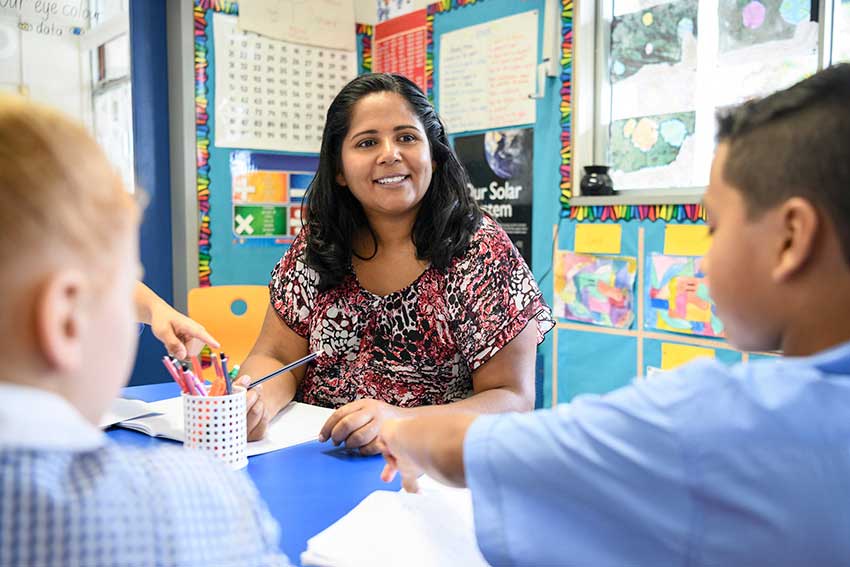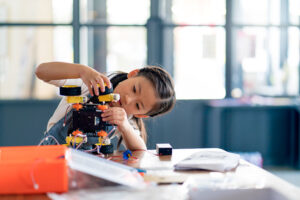How to prepare your students for ICAS: 7 tips for teachers, from teachers

We often hear from teachers who know all about the benefits of school competitions, but struggle with preparing for them. Your school has signed up for ICAS for the first time, and you want to set up your students for success but don’t know exactly how. Or, you know all the ins and outs of ICAS, but can’t find the time in your busy timetable to give them the support you know they deserve.
At its best, preparing for assessments means setting students up for a rewarding school life, a continuous journey of character formation, and a lifelong love of learning. This is precisely the case with the world-renowned ICAS competitions.
But preparing for ICAS doesn’t have to be at the expense of your time, effort, or regular teaching schedule. To find out how, we spoke to two former classroom teachers on the ICAS Assessments team about what methods they used for their students ahead of ICAS.
Teaching to the learner, not ‘teaching to the test’
ICAS is unique in that it doesn’t test rote knowledge, but instead how students put their existing knowledge to use to solve problems. Given this, preparation techniques can be a little less obvious compared with regular tests.
Nardin Hanna, ICAS Assessment Consultant, is very familiar with the full scope of preparing students for both types of tests — as a former K-2 coordinator, NAPLAN marker, NSW syllabus writer and Primary teacher of 10 years. “The beauty of preparing for ICAS is that it’s not about teaching to the test. It’s about equipping students to be able to apply their knowledge, skills and understanding,” she says. “You’re teaching students how to think and how to come up with the answers.”
In other words, instead of ‘teaching to the test’, we should aim to teach to the learner. On face value, that may seem easier said than done in a classroom with dozens of students. But is it possible to exercise these critical thinking skills in a way that suits individual learners? Yes! Here are some classroom-proven tips.
1. Run mock tests and workshop the answers as a class.
Mary-Anne Kefaloukos, ICAS Customer Experience Manager, and a former specialist Science teacher, found a technique which worked: she would get students to complete ICAS past papers and workshop all the solutions together as a class (this works with RiSE+ too).
Nardin agrees that this is a useful method, adding: “After we did a mock test, we’d go through it and mark it together as a group to see how well they did. I’d conduct the session as a voting process for each question. That way I could see exactly who answered what and immediately identify their strengths and weaknesses.”
At the marking and workshopping stages, Nardin and her students would go through one question at a time. She would ask them to raise their hand for each answer to see the distribution of responses. If most of the class voted for the correct answer, she’d confirm their understanding by asking one or two students to explain their rationale to the group.
If more than one answer choice was popular — and therefore the group was divided over which was the correct answer — she’d ask students to discuss the question either in small groups or as a class. She would then prompt them along the way as to why each chosen method would or would not work, and therefore together, they would reach the correct answer.
If most of the class chose the incorrect answer, Nardin would herself provide a clear and direct explanation of the solution and the best way to reach the solution.
The beauty of this approach is that it makes progress visible and rewarding for both students and teachers.
“When we did another trial paper the following week, a lot of them picked up on the prior methods that were used. They’d say, I remember you said this is how to do it — I did it, and I got it right!
“And then we’d go through the voting process again where I’d always ask them — how did you get that answer? Again, I’d use this time to really highlight the things that they didn’t know, then spend time teaching them the skills of how to problem solve and work out the answer.”
As competition day approaches, you can move on to running mock tests under exam conditions to help your students, especially the younger ones, prepare for the full exam experience. If you’re able to run several during the lead-up to test day, even better.
2. ‘Chunking’ into smaller sets of questions can help both you and your students.
The question-by-question approach that Nardin uses has additional benefits. Breaking down past papers into smaller sets of (or even individual) questions — a technique known as ‘chunking’ — helps keep ICAS preparation manageable for you, and digestible for your students.
Imagine trying to paint a whole house in one go. Most of us would find this a tall order. But if you paint one room at a time, section by section, the end goal now feels much more within reach. Similarly, tackling a whole test paper at once might seem daunting at first, but focusing on a couple of questions at a time feels much more achievable. It also allows students to focus their full attention on each ‘chunk’, helping them to retain whatever they learn.
And of course, chunking also makes it a lot easier for you to fit ICAS preparation into your packed teaching schedule. Finding time to tackle a question or two per day is a lot more achievable than a rare one-hour spare slot.
3. A problem a day keeps the brain fog away.
Try making it a daily routine in the lead-up to ICAS to take 10-15 minutes a day to exercise students’ problem-solving muscles with one or two ICAS questions. Again, this can help solve the very real problem of fitting in ICAS preparation when you’re time-poor and juggling packed timetables. Nardin says: “It’s a lot easier if you break it down to one problem a day, use it as a fun ‘brain break’ with team points and rewards, or even as a lunchtime club for the really keen students.”
4. Make ICAS prep doubly useful by matching practice questions to the syllabus.
ICAS preparation doesn’t necessarily need to run separately from your syllabus topics. You can combine the two as extension exercises for early finishers, or stimulating whole-class activities. With a little bit of your own preparation, practising for ICAS can help reinforce students’ understanding and application of topics they’re already learning about.
“You can actually match the ICAS questions to the syllabus,” says Nardin. “You can look through the questions and figure out which topic or outcome each question relates to. So, if you’ve got a particular grade level and you’re teaching that related topic, you can use the ICAS question as an extension for that lesson. I think a lot of teachers would use this because we already cater for early finishers in class and the questions are already made and designed to challenge students!
“For example, if today I’m teaching about climate and I remember in ICAS Science there is a question which links to the Earth & Beyond topic, I’d use that problem-solving question and see how well my students can perform, and if they’ve truly understood the topic.”
5. Practise peer learning, not ‘teacher-knows-all’.
An effective and fun way to ensure you’re teaching to the learner rather than the test is to foster an environment where students learn with and from each other, as opposed to by themselves or through spoon-fed answers from the teacher.
When preparing for ICAS Science competitions, Mary-Anne said she would use variations of the ‘think, pair and share’ strategy, where students first think individually about a question, and then share ideas for solutions with their classmates.
“I had higher-order thinking science questions prepared – from science textbooks that I bought or some I made up myself, she said “I modelled answering a question to the class, then asked students to answer them in pairs, sharing their individual strategies with each other, then they had a go at other questions individually. I was basically handing over the thinking and problem-solving process to them gradually to build up their confidence with practice.”
Nardin believes that there are a number of benefits to this type of approach. She says: “There’s no one way to learn. Teacher-based instruction — saying, OK, this is how you do it, memorise it and go — that’s not the point with ICAS.
“Different students learn in different ways. It’s important that you hear and understand how different students’ minds work, so that the other students can take on board all those strategies and then create their own. It also provides a space for teachers to deliver effective feedback: echoing correct responses, elaborating on tentative or partially correct responses, or explaining incorrect responses. As a result, when you open it up to peer learning and whole-class discussion, it promotes better engagement, collaboration and communication.”
6. Communication and collaboration beat memorisation.
This collaborative learning approach isn’t just more stimulating and engaging for you and your students — it’s also particularly useful for the higher-order thinking skills required for competitions such as ICAS. ICAS questions go beyond memorising facts or even demonstrating knowledge; they’re designed to nurture and assess students’ ability to untangle a problem. We all know the value of learning ‘laterally rather than literally’, and Nardin believes that collaboration is a useful way to encourage this critical and creative thinking.
“When students share their thought strategies aloud, they’re explaining the process of their thinking and what their mind went through, step by step to get to that result. And that’s how students learn. It’s exposure, it’s practice, it’s play,” she says.
In other words, play-based and inquiry learning is beneficial for students of all ages — and banding together to tackle tricky ICAS questions is an easy way to incorporate the pedagogy of play in the classroom.
7. Encourage a mindset of learning, not performance.
Students who are sitting ICAS are choosing to go outside their comfort zone. Taking on this ‘risk’ helps them build a mindset that prioritises growth over comfort: playing to win over playing not to lose, and long-term mastery over short-term performance.
According to Mary-Anne, achievement doesn’t necessarily mean top marks – every student will walk away a winner no matter how many questions they get wrong. She says: “One piece of advice that I gave my students was that it’s OK even when you don’t do so well in an exam. There’s always a next time and it’s important to remember that, as Einstein said, ‘Failure is success in progress’. Failure isn’t permanent, and you often learn the best lessons from it.”
Nardin agrees that learning how to ‘fail forward’ is a crucial skill for all areas of life.
“It’s like riding a bike,” she says. “You fall so many times in the beginning, but the more you practise and the more you expose yourself to it, you start to pick up on it and gradually get better. We always teach our students to try their best, and at the end of the day, the only person they should be competing against is themselves. Am I better than yesterday? Yes. So therefore, I’ve made an improvement. Have I learnt something new today? Yes. Therefore, I should acknowledge and celebrate my improvement.”
ICAS preparation can work together with — not just on top of — the scope and schedule of your regular classroom teaching. There’s still time to register for ICAS 2022 — visit the shop today.



